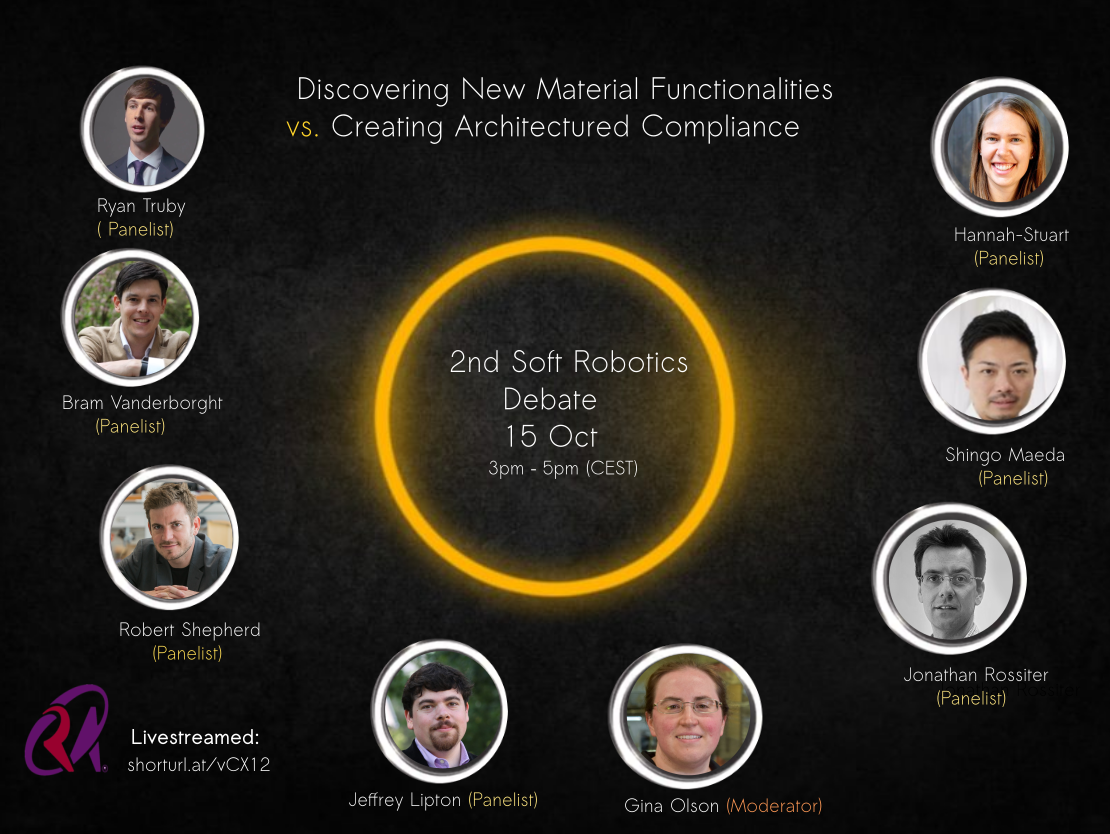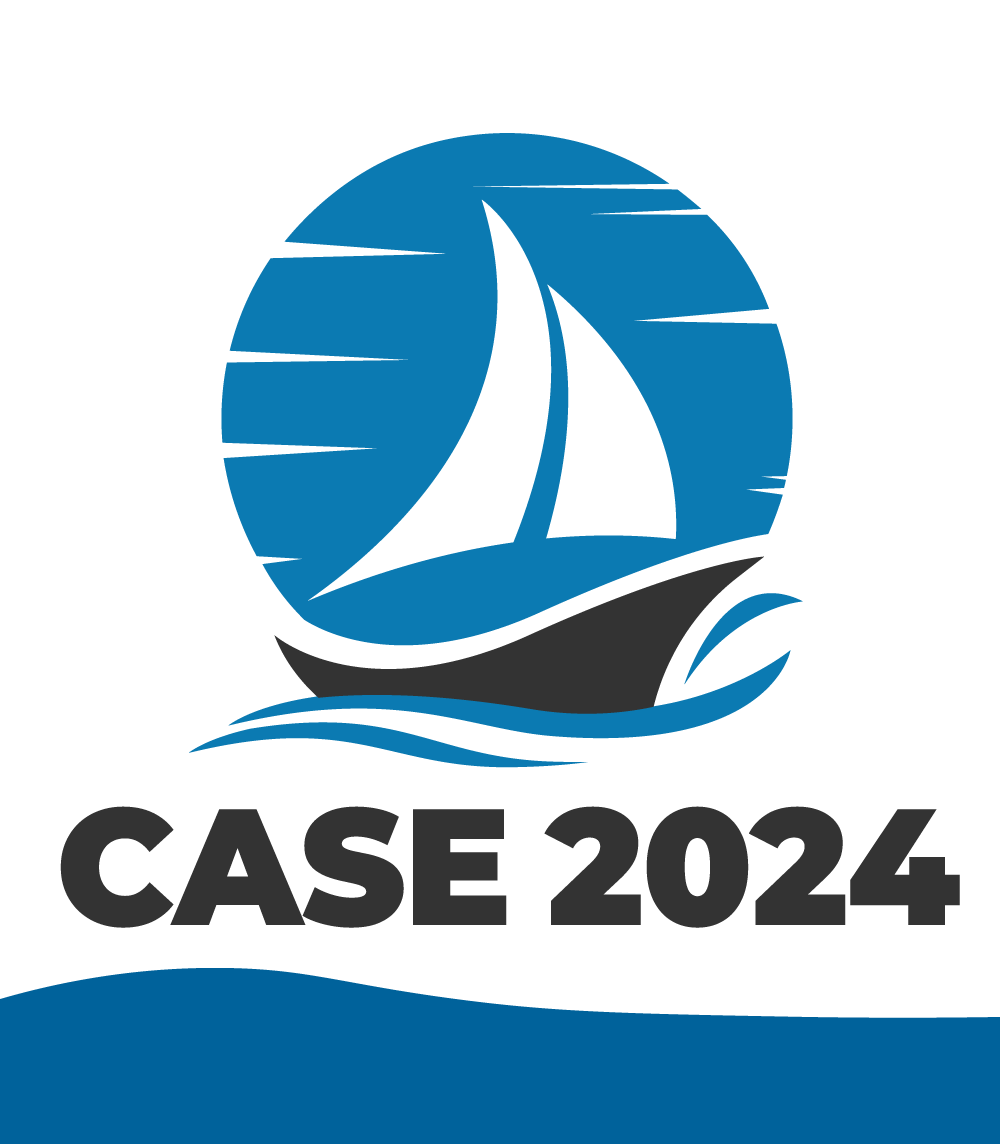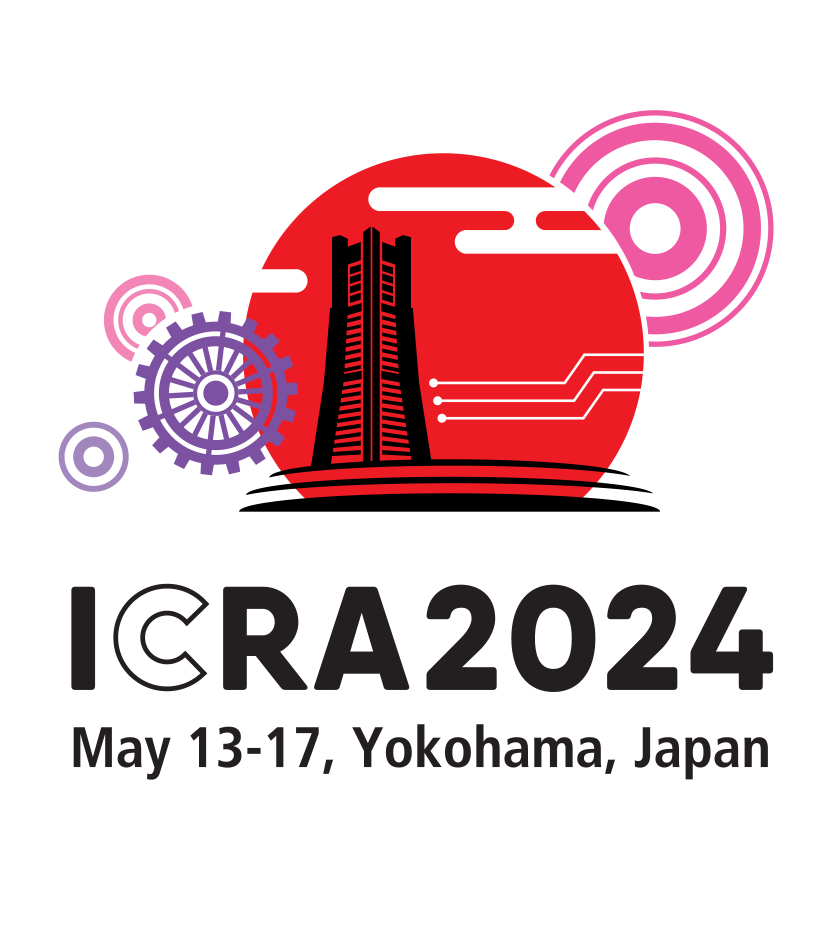RAS TC on Soft Robotics presents its 2nd debate!
Organizers:Dr. Marwa ElDiwiny, Dr. S.M.Hadi Sadati, Dr. Laura Blumenschein
Different controversial topics in Soft Robotics, such as future and potential impact, real-world deployment, morphological computation vs. traditional control methods, etc., are frequent subject of debates. General community can benefit from making these debates more formal and publicly available. Debates are 80 minutes long with 4-6 participants and a moderator from recognized experts in the field.
Upcoming Soft Roboitics Event:
”Bridging the Gap Between Soft Robots and Soft Materials: Discovering New Material Functionalities vs. Creating Architected Compliance”

When: Thursday, Oct 15, 2020 3:00 pm CEST
Where: IEEE Webex (no registration required)
Materials science research into compliant materials is well established, yet a gap still exists between cutting edge materials and implemented soft robots. In this debate, we will bring together experts in the fields of soft materials and soft robotics to discuss the necessary steps to bring more collaboration between these two fields. We will try to answer whether material development should focus on developing new functionalities for soft robots or on creating optimized materials to meet existing needs, allowing for easier rapid prototyping and technology transferability.
Panelists:
Dr. Jeffrey I. Lipton is an assistant professor at the University of Washington in the Mechanical Engineering Department with a courtesy appointment in the Paul G. Allan School of Computer Science and Engineering. He uses robotics to expand the set of programable material properties and uses programmable materials to enhance the capabilities of robots. He was previously a Post-Doctoral Associate at the MIT’s CSAIL in the Distributed Robotics Lab under Daniela Rus. He received his BS in Applied and Engineering Physics and PhD in Mechanical Engineering from Cornell. His Ph.D. work was under Hod Lipson in the Creative Machines Lab. His past work on 3D printed foods and 3D printing for the hospitality industry has influenced two of the largest 3D printing companies in America and garnered media attention from the New York Times, BBC, and others. He was the lead developer for the Fab@Home project which supported life science and food science researchers’ 3D printing needs on all six habitable continents.
Dr. Shingo Maeda is an associate professor at the Department of Engineering Science and Mechanics, Shibaura Institute of Technology, since 2014. His research focus is on creating “soft” machine systems in contrast to “hard” machine systems which have achieved conventional “precision” and “accuracy”. He is pursuing research based on the concept of “softness”, e.g. Chemical Robots (Belousov-Zhabotinsky Gel – BZ Gel), Soft Mechatronics (DEAs, Stretchable suction cup with electroadhesion), Electro HydroFluid Machines (ElectroHydroDynamics – EHD), and Statistical-Physical Modeling.
Prof. Jonathan Rossiter is a Professor of Robotics and head of the Soft Robotics group at Bristol Robotics Laboratory. In his robotic actuator and artificial muscle research he has been developing new polymer-composite actuators involving principles of buckling and bi-stability and robots which are inspired by bio-mimetic study of swimming organisms, including bacteria and fish. His research also include bio-mimetics, artificial intelligence, composites, sensors and the wider robotics field. Bio-mimetics is an engineering tool that covers a huge scale from the tangible nano-technology level, including materials, actuators and sensors, right up to the intangible level of artificial intelligence, including high-level perception, cognition and reasoning.
Prof. Robert Shepherd is the director of The Organic Robots Laboratory (ORL) at Cornell University that focuses on using organic chemistry of soft material composites for new capabilities in robots. He is focused on the material and mechanical design of soft machines. His work begins by identifying new material compositions for actuators, then mapping them onto a compatible mechanical system for motion. Due to the compliance of his soft material systems, the resulting machines are underactuated (e.g., they have more degrees of freedom than actuators) and much of their capabilities arise from this property. His interests lie in further developing the abilities of these soft machines.
Dr. Hannah Stuart has been an Assistant Professor of Mechanical Engineering at the University of California Berkeley since January 2018, and is a faculty member of the Jacob’s Institute for Design Innovation. She received her BS in Mechanical Engineering from the George Washington University in 2011, then completed her MS and PhD in Mechanical Engineering from Stanford University in 2013 and 2017 respectively. Professor Stuart’s research interests include dexterous manipulation, robotics, bioinspired design and human haptics and she runs the Embodied Dexterity Group research lab (edg.berkeley.edu). She is a Hellman Faculty Fellow and recently received an Outstanding Service award from the IEEE Robotics and Automation Society.
Dr. Ryan L. Truby is a Postdoctoral Fellow at MIT’s Computer Science and Artificial Intelligence Lab working on the design, fabrication, and control of soft robots. He is currently developing new materials and manufacturing strategies for creating sensorized soft robots, as well as deep learning-based frameworks for their control. Before MIT, Ryan received his Ph.D. in Applied Physics from Harvard University, where he developed 3D printing strategies for fabricating novel soft robotic systems, such as the entirely soft, hardware-free Octobot he developed as part of a collaboration at Harvard’s Paulson School of Engineering and Applied Science and Wyss Institute. His research also includes work in 3D printed vascularized tissue constructs, soft electronics, artificial muscles, and architected materials. Ryan’s work at the materials-robotics interface has been supported by an NSF Graduate Research Fellowship and a Schmidt Science Fellowship, and he has received awards in both fields, including the Gold Award for Graduate Students from the Materials Research Society and the Outstanding Paper Award at the 2019 IEEE International Conference of Soft Robotics. Ryan is an Adjunct Assistant Professor of Materials Science and Engineering and Mechanical Engineering at Northwestern University, where he will begin as a tenure-track Assistant Professor and Core Member of Northwestern’s Center for Robotics and Biosystems next year.
Prof. Bram Vanderborght is a professor at the VUB since 2009. Currently he coordinates EU FET SHERO SHERO project and Marie Curie ITN SMART project, he is VUB-PI of EU project SOPHIA, and he is the core lab manager of Flanders Make in Flexible Assembly and member of Brubotics . He is also the Editor In Chief of IEEE Robotics and Automation Magazine. His research interests include the use of soft and self healing actuators for cognitive and physical human robot interaction in applications in health and manufacturing. Our work is on display in the AI Experience Center .
Moderator: Dr. Gina Olson is a postdoc researcher at Carnegie Mellon University. She is a Mechanical Engineer with a specialty in highly deformable structures, a problem which stretches across industries. She has experience designing and simulating deployable structures for small satellites, designing and qualifying aerodynamic seals and developing soft robotic actuators. Her current work focuses on understanding and improving single- and multiple-actuator soft robotic systems for underwater applications. She is specifically interested in models formulated for design and novel fabrication techniques. Gina earned her Bachelor of Science in Mechanical Engineering from Rose-Hulman Institute of Technology in 2010, and her Master of Science in Aeronautical Engineering from California Institute of Technology in 2011. Prior to attending Oregon State University, Gina worked as a Technical Lead Engineer at Meggitt Polymers and Composites, designing and certifying engine seals for commercial passenger aircraft.
The Debate is expected to be approximately 80 minutes long.
Additional questions for the debate panel may be submitted in advance- here.







